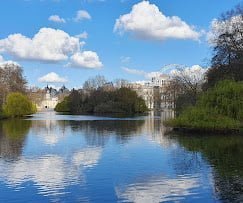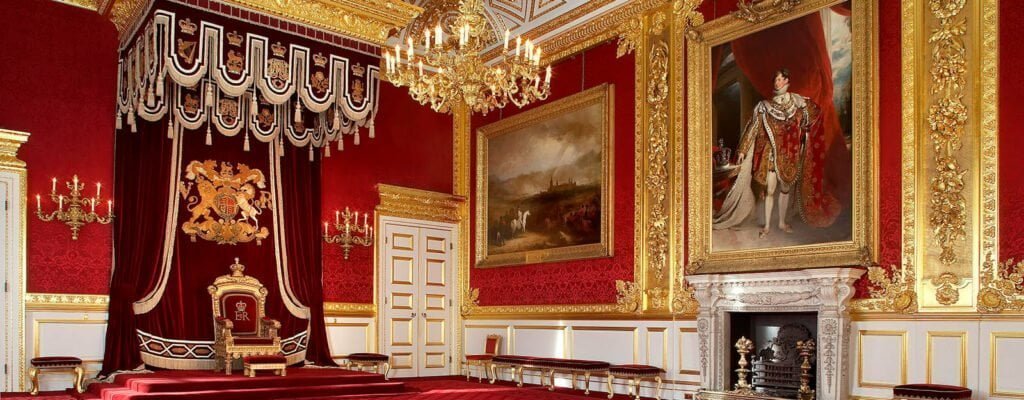London Walk: 8 Surprising Facts You Need To Know about St James’ Palace

Standing with a regal air of silent beauty amidst the bustling city of London, St James’s Palace is a testament to Britain’s rich history. As the oldest royal residence in the United Kingdom, it has been a silent witness to the lives and times of the British monarchy for nearly five centuries. Built between 1531 and 1536, the palace is a rare and beautiful example of Tudor architecture, its distinctive red-brick façade imbued with the stories of kings, queens, princes, and princesses who once called it home.

The palace was commissioned by King Henry VIII, a formidable figure of the Tudor dynasty, and it was built on the site of a former leper hospital dedicated to Saint James the Less, hence its name. Over the years, it has been the backdrop to many a royal event, from the final night of King Charles I before his execution in 1649 to the joyful baptism of Prince George in 2013 in the Chapel Royal.
St James’s Palace was the birthplace and childhood home of Queen Victoria, whose reign is remembered as a period of industrial, cultural, political, scientific, and military change within the United Kingdom. Yet, the palace’s significance extends beyond its role as a royal residence; it is also an important administrative hub of the monarchy, housing the offices of several members of the royal family.
Perhaps most strikingly, the palace is the location where the transition of the monarchy takes place. It is here that the Accession Council meets to proclaim the new monarch, a tradition that has been followed for over two centuries. In this sense, St James’s Palace is not merely a place of residence; it is the beating heart of the British monarchy, a place where history unfolds and the future is shaped.
Despite the grandeur of Buckingham Palace and the allure of Kensington Palace, St James’s Palace holds its own, embodying an intricate blend of historic relevance, architectural grandeur, and ongoing royal significance. It is a symbol of Britain’s enduring monarchy, a bastion of tradition, and a beacon of continuity in an ever-changing world.
Oldest Royal Residence: St James’s Palace is the oldest Royal residence in the UK. Although Buckingham Palace is the Queen’s official residence, St James’s Palace is still the senior palace and the ceremonial Royal residence. For example, foreign ambassadors are accredited to the Court of St James’s.
Before it became the royal residence that we know today, the site where St James’s Palace stands was home to the Hospital of St James, a leper hospital founded in the twelfth century. This hospital, like others of its time, was situated away from the main populace of London, chosen for its isolation, as leprosy was a highly contagious disease and was greatly feared in medieval times.
During this period, leprosy was a misunderstood condition, often associated with sin and moral failing. Those afflicted were frequently cast out from society and sent to live in hospitals like the one at St James, which were more like isolated colonies than the hospitals we know today. The Hospital of St James served as a sanctuary, providing care and shelter for those ostracized due to their condition.The hospital was dedicated to Saint James the Less, hence its name. Saint James the Less is often depicted with a fuller’s club, which, in a macabre twist of symbolism, resembles a crutch, a tool frequently used by leprosy patients affected by the disease’s debilitating effects.
By the time of King Henry VIII in the 16th century, the disease had significantly declined, and the hospital had fallen into disuse. Viewing the site as an ideal location for a new palace, Henry VIII acquired the property and commissioned the construction of St James’s Palace. Despite the stark contrast between its original use and its later royal purpose, the site’s historical significance as a place of sanctuary and care remains an integral part of its rich and complex history.
Tudor Architecture: Constructed by King Henry VIII between 1531 and 1536, St James’s Palace remains one of the few surviving examples of Tudor architecture in London. The palace was built on the site of a former leper hospital dedicated to Saint James the Less, from which it gets its name.
Home to Royals: Despite being less famous than Buckingham Palace, St James’s Palace has been the residence of several monarchs. King Charles I spent his final night at this palace before his execution in 1649. The palace was also the birthplace and childhood home of Queen Victoria.
![By André Mollet - from [1], Public Domain, https://commons.wikimedia.org/w/index.php?curid=53854891](https://richwoman.co/wp-content/uploads/2023/05/St_Jamess_Park_original_layout.jpg)
Royal Court: The Palace is still very much in use. Even though the reigning monarch does not reside there, St James’s Palace is the administrative centre of the monarchy. It houses the offices of several members of the royal family.
Chapel Royal: The Chapel Royal at St James’s Palace has been the location of many significant royal events, including the baptism of Prince George, the son of the Duke and Duchess of Cambridge, in 2013.
Monarch’s Accession Council: Whenever a new monarch ascends to the throne, the Accession Council meets at St James’s Palace. This has been the tradition for over two centuries.
Proclamation Gallery: The Proclamation Gallery at the palace is the location where the accession of a new monarch is officially announced. In 1952 Her Majesty Queen Elizabeth II was also proclaimed here. The balcony, overlooking Friary Court, is where the Accession Proclamation is traditionally read out to the public.
Private Royal Residence: The palace remains a private residence for several members of the Royal Family. Princess Anne, the Queen’s daughter, maintains an apartment at St James’s Palace. Additionally, it was the official residence of Prince William and Prince Harry until 2013.
Standing with an air of silent regality amidst the bustling city of London, St James’s Palace is a testament to Britain’s rich monarchical history. As the oldest royal residence in the United Kingdom, it has been a silent witness to the lives and times of the British monarchy for nearly five centuries. Built between 1531 and 1536, the palace is a rare and beautiful example of Tudor architecture, its distinctive red-brick façade imbued with the stories of kings, queens, princes, and princesses who once called it home.
The palace was commissioned by King Henry VIII, a formidable figure of the Tudor dynasty, and it was built on the site of a former leper hospital dedicated to Saint James the Less, hence its name. Over the years, it has been the backdrop to many a royal event, from the final night of King Charles I before his execution in 1649 to the joyful baptism of Prince George in 2013 in the Chapel Royal.
St James’s Palace was the birthplace and childhood home of Queen Victoria, whose reign is remembered as a period of industrial, cultural, political, scientific, and military change within the United Kingdom. Yet, the palace’s significance extends beyond its role as a royal residence; it is also an important administrative hub of the monarchy, housing the offices of several members of the royal family.
Perhaps most strikingly, the palace is the location where the transition of the monarchy takes place. It is here that the Accession Council meets to proclaim the new monarch, a tradition that has been followed for over two centuries. In this sense, St James’s Palace is not merely a place of residence; it is the beating heart of the British monarchy, a place where history unfolds and the future is shaped.
Despite the grandeur of Buckingham Palace and the allure of Kensington Palace, St James’s Palace holds its own identity, embodying an intricate blend of historic relevance, architectural grandeur, and ongoing royal significance. It is a symbol of Britain’s enduring monarchy, a bastion of tradition, and a beacon of continuity in an ever-changing world.






